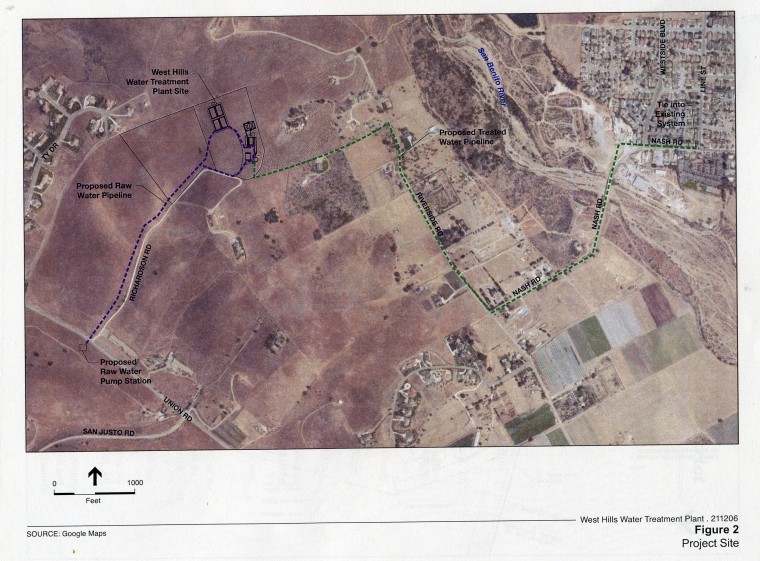
Local officials held a public meeting Thursday to discuss the notice of preparation of an Environmental Impact Report for the West Hills Water Treatment Plant.
The project is expected to cost $18 to $20 million and has been scaled down to one-fifth of its original size since it was first conceived in 2004.
Harry Blohm, the project manager, said the project idea came about in 2004 when the county water district, the City of Hollister and San Benito County signed a contract that a new water treatment plant was needed in the community. Sunnyslope Water District joined the project in 2008.
“It would help with the overall reliability of water,” Blohm said, noting that the project is not meant to meet the needs of future growth but of existing needs in the community. “All the agencies have been concerned about that … the other element is water quality.”
The estimated timeline calls for construction to begin in 2014 through fall 2015. Final testing and startup is estimated to take three months, with the plant set to start work in late 2015 or early 2016.
The proposed project would include construction and operation of a raw water pump station, and raw and treated water transmission pipelines. The initial design will include a capacity of 4.5 to 6 million gallons per day, with potential for expansion to process up to 9 million gallons per day.
It would add to other existing water treatment plants, with the goal of increasing capacity and quality, and would be built to largely accommodate current residents, not future growth, officials said. Initial projections called for about a $10 increase to water rates, but that number should dip with the downsized plans.
“Very little of the capacity that will be built is for future growth,” said Jeff Cattaneo, the water district manager. “The majority of it is for the existing homes that are in the City of Hollister.”
The treatment plant is proposed on the southwestern boundary of Hollister in the hills north of Union Road, on two parcels totaling about 33 acres that are jointly owned by the city and Sunnyslope Water District. The water treatment site would be adjacent to Richardson Road, with a proposed raw water pump station along Union Road and treated water pipelines on Riverside Road.
Blohm said the officials considered five or six criteria when looking for a site for the water treatment plant.
“The number one was a location that is nicely placed in the system, to make deliveries into the system with a high-quality water so distribution is equitable throughout the whole system,” Blohm said.
Other considerations included cost, a location close to the source water, a place that would have minor environmental concerns and an elevated area that would allow water delivery by using gravity for most of the year without using pumps to move it down into the system.
The cost and funding possibilities for the project are still in flux. The water district will fund part of it, with a bond or loan potentially covering the rest. The agencies continue to discuss the funding options. Water rates are also likely to go up, but Blohm said the scaling back of the project from initial plans will mean that the rate increase will be lower than the original plan idea back in 2006, of around $10.
“The project is much reduced,” Blohm said. “It’s 20 percent of the size that was originally conceived. Affordabilty was a major factor.”
Cattaneo said the availability of water can change from year to year. San Benito and city residents rely on water from groundwater, local surface water and imported surface water from the federally operated Central Valley Project. Of the imported water, Cattaneo said about 25 percent goes to urban residents and the other 75 percent is used by agriculture. He said in recent years allocations have been cut back due to environmental concerns in the delta, but last year’s allotment was up.
The local water district is also banking water that is not used so that it will be available in drought years.
“We are doing a lot of things to ensure we diversify our water portfolio so we can deliver a reliable supply,” he said.
Residents have until Sept. 8 to comment on the notice of preparation for the EIR.
“All three of the agencies have all come together and all agreed upon the best project,” Cattaneo said. “We are all moving in the same direction and moving in complete harmony with the whole project, which is something you don’t see real often.”









